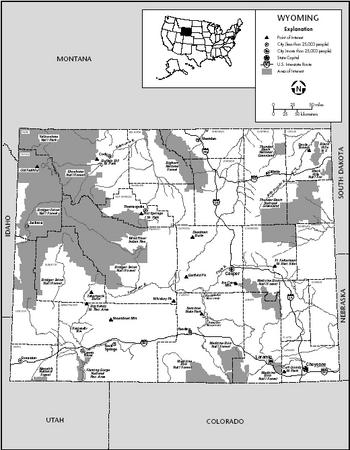Wyoming
History
The first human inhabitants of what is now Wyoming probably arrived about 11,500 BC. The forebears of these early Americans had most likely come by way of the Bering Strait and then worked their way south. Sites of mammoth kills south of Rawlins and near Powell suggest that the area was well populated. Artifacts from the period beginning in 500 BC include, high in the Big Horn Mountains of northern Wyoming, the Medicine Wheel monument, a circle of stones some 75 ft (23 m) in diameter with 28 "spokes" that were apparently used to mark the seasons.
The first Europeans to visit Wyoming were French Canadian traders. The Vérendrye brothers, Francois and Louis-Joseph, probably reached the Big Horn Mountains in 1743; nothing came of their travels, however. The first effective discovery of Wyoming was made by an American fur trader, John Colter, earlier a member of the Lewis and Clark expedition. In 1806–07, Colter traversed much of the northwestern part of the state, probably crossing what is now Yellowstone Park, and came back to report on the natural wonders of the area. After Colter, trappers and fur traders crisscrossed Wyoming. By 1840, the major rivers and

Between 1840 and 1867, thousands of Americans crossed Wyoming on the Oregon Trail, bound for Oregon or California. Migration began as a trickle, but with the discovery of gold in California in 1848, the trickle became a flood. In 1849 alone it is estimated that more than 22,000 "forty-niners" passed through the state via the Oregon Trail. Fort Laramie in the east and Fort Bridger in the west were the best-known supply points; between the two forts, immigrants encountered Independence Rock, Devil's Gate, Split Rock, and South Pass, all landmarks on the Oregon Trail. Although thousands of Americans crossed Wyoming during this period, very few stayed in this harsh region.
The event that brought population as well as territorial status to Wyoming was the coming of the Union Pacific Railroad. Railroad towns such as Cheyenne, Laramie, Rawlins, Rock Springs, and Evanston sprang up as the transcontinental railroad leapfrogged across the region in 1867 and 1868; in the latter year, Wyoming was organized as a territory. The first territorial legislature distinguished itself in 1869 by passing a women's suffrage act, the first state or territory to do so. Wyoming quickly acquired the nickname the Equality State.
After hostile Indians had been subdued by the late 1870s, Wyoming became a center for cattlemen and foreign investors who hoped to make a fortune from free grass and the high price of cattle. Thousands of Texas longhorn cattle were driven to the southeastern quarter of the territory. In time, blooded cattle, particularly Hereford, were introduced. As cattle "barons" dominated both the rangeland and state politics, the small rancher and cowboy found it difficult to go into the ranching business. However, overgrazing, low cattle prices, and the dry summer of 1886 and harsh winter of 1886/87 all proved disastrous to the speculators. The struggle between the large landowners and small ranchers culminated in the so-called Johnson County War of 1891–92, in which the large landowners were arrested by federal troops after attempting to take the law into their own hands.
Wyoming became a state in 1890, but growth remained slow. Attempts at farming proved unsuccessful in this high, arid region, and Wyoming to this day remains a sparsely settled ranching state. What growth has occurred has been primarily through the minerals industry, especially the development of coal, oil, and natural gas resources during the 1970s because of the national energy crisis. However, the world's oil glut in the early 1980s slowed the growth of the state's energy industries; in 1984, the growth of the state's nonfuel mineral industry slowed as well.
Wyoming's population, which had risen 41% during the minerals boom of the 1970s, declined, leaving the state ranking 50th in population in the 1990 census, having ceded 49th place to Alaska in the decade since 1980. In the 1990s, Wyoming's economy has been spurred by a rise in oil prices and expanding coal production, as well as increased tourism.
In the summer of 1988, wild fires raged through Yellowstone National Park, damaging nearly one-third of the park's total area. Gray wolves, eradicated from the mountains of Wyoming and Idaho in the 1930s, were reintroduced to Yellowstone National Park and central Idaho in 1995 and 1996 as part of the US Fish and Wildlife Service's wolf reintroduction program. The program was initiated to fufill a goal of the Endangered Species Act, passed in 1973. It was subjected to legal challenge in 1997, but the wolf reintroduction program was ruled legal in 2000. In 2003, the US Fish and Wildlife Service reclassified the gray wolves in the northern Rockies from an "endangered" to a "threatened" species, due to the growing wolf populations in those areas.
In 2003, Wyoming had a $169 million budget surplus, largely due to an increase in mineral revenues. Rising health care costs and the need to pay for new state buildings and schools caused Democratic Governor Dave Freudenthal, elected in 2002, to call for increases in property taxes.